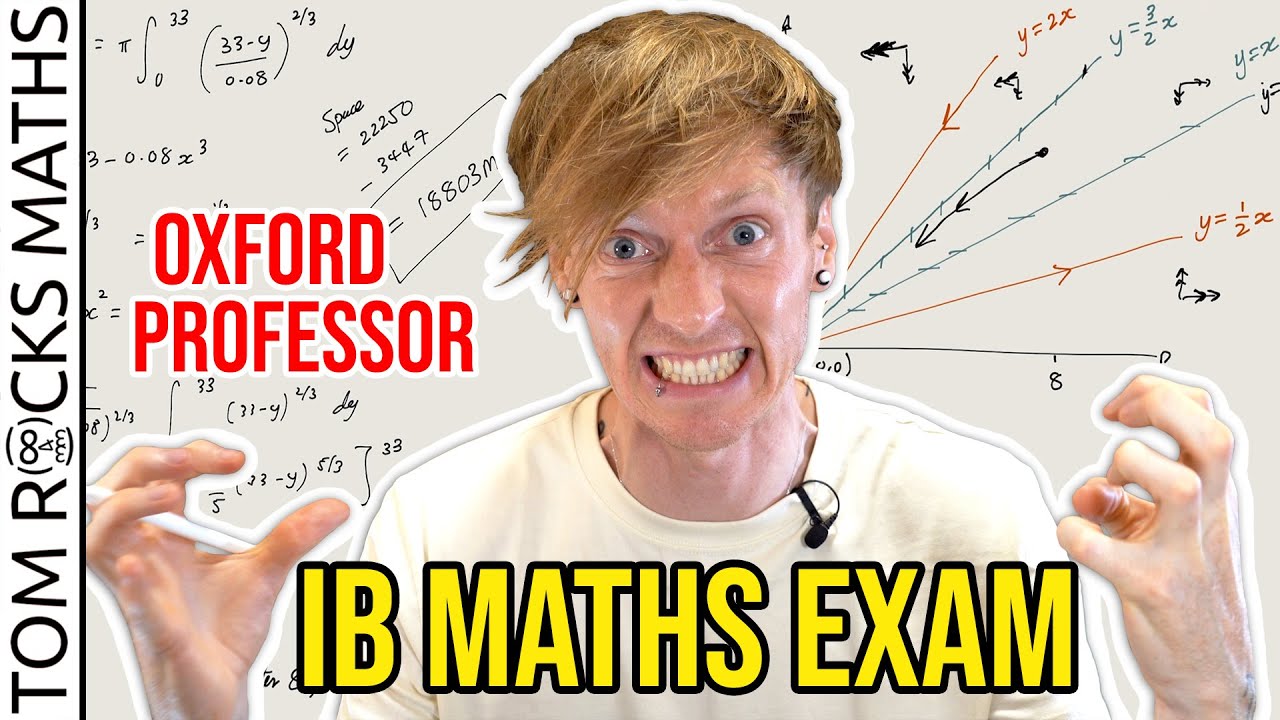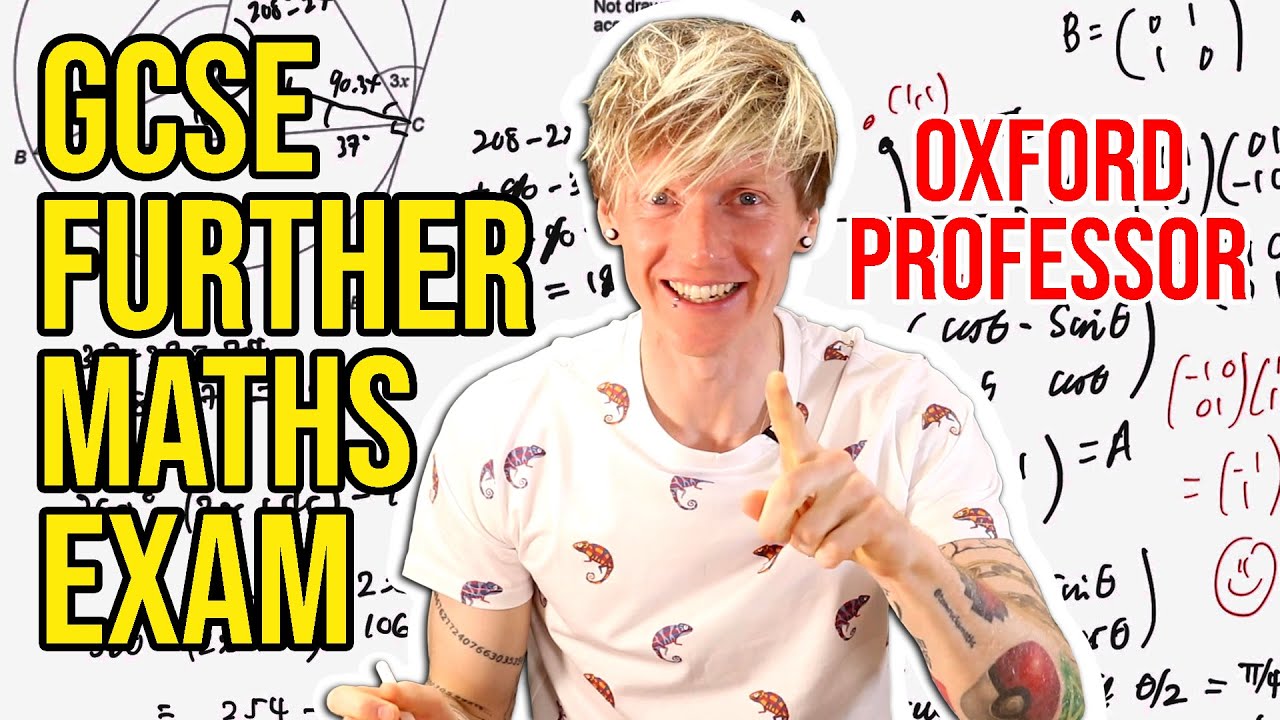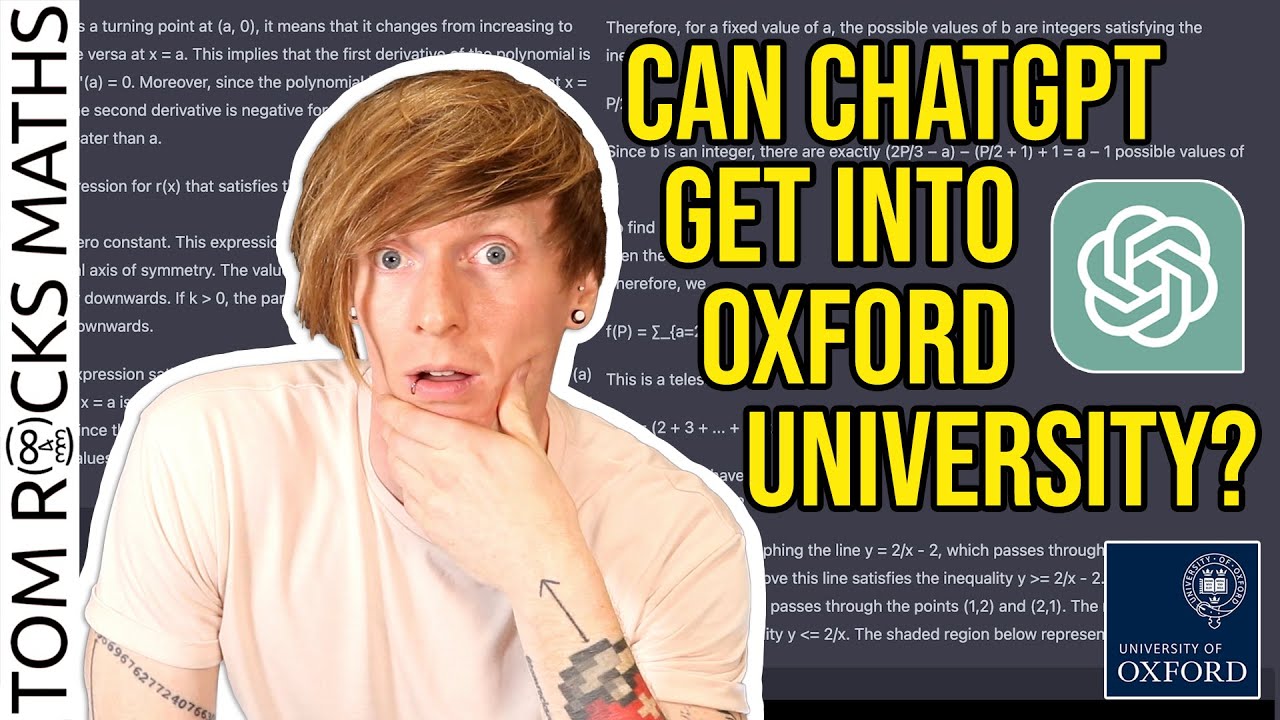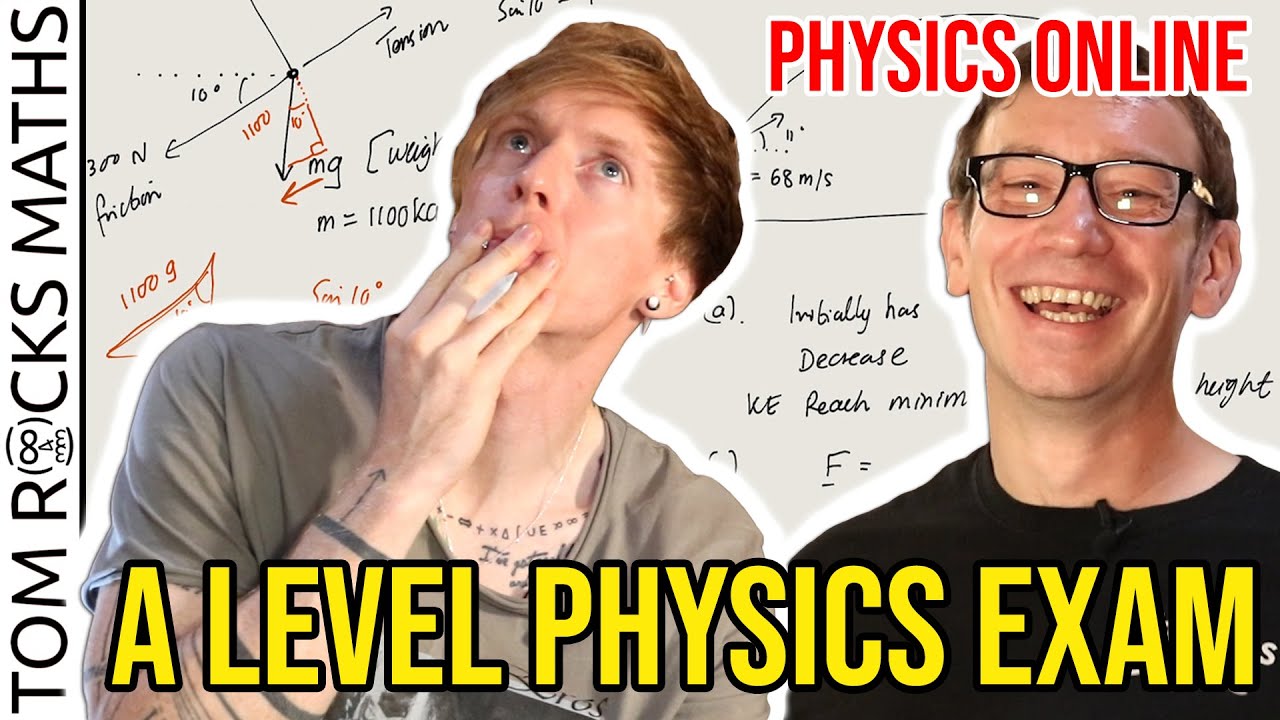Oxford University Mathematician takes Cambridge Entrance Exam (STEP Paper) PART 1
TLDRIn this video, Dr. Tom Crawford from the University of Oxford takes on the Cambridge University entrance exam, known as the STEP paper, for a unique challenge. He attempts the 2021 version of paper 2, which covers A-level math and AS-level further math topics, with 12 questions to be answered in three hours. Despite no preparation, he tackles questions from pure mathematics, mechanics, and probability & statistics, showcasing his problem-solving process and mathematical insights. The video offers a deep dive into the exam experience, with Dr. Crawford's commentary on his thought process and strategies.
Takeaways
- 🎓 Dr. Tom Crawford from the University of Oxford is attempting the Cambridge University entrance exam, known as the STEP paper, without any preparation.
- ⏱ The exam consists of 12 questions with a time limit of three hours, and candidates must answer six questions in total.
- 📚 The exam is divided into three sections: Pure Mathematics (Section A), Mechanics (Section B), and Probability and Statistics (Section C).
- 📉 Dr. Crawford decides to focus on Pure Mathematics for his answers, avoiding sections B and C due to less familiarity with their content.
- 🔍 In tackling the first question, Dr. Crawford uses trigonometric identities to prove a formula involving cos(a) and cos(3a), demonstrating the process of mathematical reasoning.
- 📝 He solves a trigonometric equation using the identities he derived, showcasing the application of mathematical formulas in problem-solving.
- 🧩 While working through the exam, Dr. Crawford faces challenges and shares his thought process, including moments of uncertainty and self-doubt.
- 🔄 The video script includes a detailed walkthrough of solving a differential equation using substitution and integration techniques.
- 📊 Dr. Crawford explores the properties of a curve with a unique tangent property and sketches the curve's graph to identify stationary points and analyze its behavior.
- 🤔 The script reveals the presenter's contemplative approach to problem-solving, including reconsidering steps and revisiting previous solutions to ensure accuracy.
- 📈 The exam concludes with a question about the properties of a matrix that represents a rotation in 2D space, leading to a discussion on the implications of matrix multiplication and determinants.
Q & A
What is Dr. Tom Crawford attempting to do in this video?
-Dr. Tom Crawford is attempting to undertake the Cambridge University entrance exam, also known as the STEP paper, specifically the 2021 version of paper 2, without any preparation.
What is the format of the STEP paper that Dr. Crawford is tackling?
-The STEP paper consists of 12 questions covering the A-level math syllabus and the AS-level further maths syllabus. Candidates are allowed three hours to answer and must choose six questions to answer, each worth 20 marks, with a maximum possible score of 120.
Why does Dr. Crawford decide to avoid questions on geometry and mechanics?
-Dr. Crawford decides to avoid geometry and mechanics questions because he admits to not liking circle theorems and not having done much mechanics when he was a student, suggesting he might have forgotten much of the specific knowledge required for those sections.
What mathematical identities does Dr. Crawford use to solve the first question on trigonometric identities?
-Dr. Crawford uses the sine and cosine addition formulas, specifically for sine(a ± b) and cos(a ± b), to prove the given identities and solve the problem.
How does Dr. Crawford approach solving the trigonometric equation in question one part one?
-Dr. Crawford uses the identities he derived earlier to transform the given equation into a form involving cos(2x) and cos(4x). He then substitutes and simplifies the equation to solve for x, considering the domain of the solution to be between 0 and π.
What is the differential equation given in question five that Dr. Crawford decides to solve?
-The differential equation given in question five is (x - a) * (dy/dx) = y - x, where 'a' is a constant. Dr. Crawford uses a substitution method to solve this equation.
What substitution does Dr. Crawford use to solve the differential equation in question five?
-Dr. Crawford uses the substitution y = (x - a) * U, where U is a function of x, to transform the differential equation into a more manageable form.
What is the curve C mentioned in question five part two, and what is its property?
-The curve C in question five part two is described by the equation y = f(x). The property of this curve is that the tangent at any point on the curve, except for the point where t = 1, passes through the point (1, t).
How does Dr. Crawford find the function f(x) given that f(0) = 0 and the curve's property?
-Dr. Crawford uses the information that f(0) = 0 and the property of the curve to find that f(x) is related to the previously solved differential equation. He concludes that f(x) involves a logarithmic function and a linear term.
What is the final decision Dr. Crawford makes regarding the remaining questions in the exam?
-Dr. Crawford decides to skip the algebra questions and proceed with question seven on matrices, as he feels more comfortable with that topic compared to algebra.
Outlines
📝 Introduction to the Cambridge STEP Exam Challenge
Dr. Tom Crawford introduces his attempt to tackle the Cambridge University entrance exam known as the STEP paper. He is taking the 2021 version of paper 2, which includes questions from both the A-level math syllabus and the AS-level further maths syllabus. With a total time limit of three hours and 12 questions to choose from, he must answer six, each worth 20 marks. Dr. Crawford has not prepared for this and plans to record his experience, including any struggles, aiming to complete the exam within the time limit and achieve a reasonable score.
🔍 Exam Strategy and Section Overview
The video script details Dr. Crawford's initial strategy for the exam, which includes avoiding questions from sections B (mechanics) and C (probability and stats) due to his unfamiliarity with these topics. He decides to focus on section A, which covers pure mathematics, as he believes he has a stronger foundation in this area. He also mentions his dislike for geometry and circle theorems, indicating that he will avoid question 6. Dr. Crawford begins his attempt with question 1, which involves trigonometric identities.
📚 Working Through Trigonometric Identities
Dr. Crawford works through proving trigonometric identities from the sine and cosine of a plus or minus B formulas. He writes out the identities for sine and cosine, and then uses them to prove a formula involving cos a and cos 3a. He simplifies the expressions step by step, eventually arriving at a formula for cos a cos 3a and a similar one for sine a cos 3a. The process involves careful algebraic manipulation and a clear understanding of trigonometric principles.
🔢 Solving a Trigonometric Equation
In this section, Dr. Crawford tackles a trigonometric equation involving cos x, cos 2x, and cos 3x. He uses the identities he proved earlier to simplify the equation and solve for x within the range of 0 to π. The process requires substituting the expressions derived from the identities and algebraically manipulating the equation to find the values of x that satisfy the given condition.
🤔 Contemplating the Solution to a Complex Trigonometric Problem
Dr. Crawford reflects on his approach to solving a complex trigonometric problem. He considers various methods, including factoring and using the quadratic formula, to find solutions for a trigonometric equation. The script reveals his thought process as he attempts to simplify the equation and find the correct factors that will lead to the solution.
📉 Analyzing the Graph of Cosine and Solving for X
The script describes Dr. Crawford's process of analyzing the cosine graph to find the values of x that satisfy the given trigonometric conditions. He marks specific points on the graph where the cosine equals certain values and then translates these into solutions for x within the specified range. This visual approach helps him to identify the correct angles that meet the problem's criteria.
🔄 Dealing with Trigonometric Identities and Equations
Dr. Crawford continues to work with trigonometric identities, focusing on the tangent function. He is tasked with proving a relationship between tan x and tan 2x, which involves expressing the tangent in terms of sine and cosine and then simplifying the equation. The process is complex, requiring the use of previously derived identities and careful algebraic manipulation.
📝 Working Through a Challenging Trigonometric Proof
In this section, Dr. Crawford is deeply engaged in a challenging trigonometric proof. He attempts to simplify expressions involving sine and cosine functions and uses various trigonometric identities to reach a conclusion. The script captures his struggle with the problem, as he tries different approaches and revisits previous steps to find a solution.
📈 Sketching Graphs and Finding Solutions
Dr. Crawford discusses the process of sketching graphs to find solutions for a given trigonometric equation. He considers the behavior of the sine function over a specific range and identifies points where the function equals zero. Additionally, he looks at where the cosine function equals one-half and finds the corresponding values of x. The script describes his methodical approach to graphing and solving for the variables within the given constraints.
✏️ Skipping Algebra for a Differential Equation
Feeling overwhelmed by the algebraic questions, Dr. Crawford decides to skip them and move on to a question about differential equations, which he finds more appealing. He expresses his preference for this type of problem and prepares to tackle it using his knowledge of calculus.
🧩 Solving a Differential Equation Using Substitution
Dr. Crawford applies a substitution method to solve a given differential equation. He introduces a new function and rewrites the equation to make it more manageable. The process involves using the product rule and simplifying the equation to a form that can be integrated. He then integrates both sides of the equation to find the solution.
📉 Analyzing the Properties of a Curve and Its Tangent
The script describes an analysis of a curve and its tangent properties. Dr. Crawford is given a function and must find the equation of the tangent at a point on the curve, which passes through another specified point. He uses the concept of the derivative to determine the slope of the tangent and sets up an equation to find the function's form.
📊 Sketching the Curve and Identifying Stationary Points
Dr. Crawford discusses the process of sketching a curve defined by a function and identifying its stationary points. He calculates the derivative of the function to find where it equals zero, indicating potential turning points. The script captures his thought process as he considers the behavior of the function as x approaches various values, including infinity and negative infinity.
🔍 Continuing the Analysis with Part B
Moving on to part B of the problem, Dr. Crawford is given additional information about the function's value at a specific point. He uses this to sketch the curve for x values greater than one and identifies the coordinates of any stationary points. The script describes his approach to understanding the function's behavior in this new domain.
📈 Sketching the Curve's Behavior for X Greater Than One
Dr. Crawford continues his analysis by sketching the curve's behavior for values of x greater than one. He considers the gradient of the curve at x equals one and how it changes as x increases. The script details his reasoning as he predicts the curve's steepness and turning points in this range.
🔚 Concluding the First Half of the Exam
After completing several questions, Dr. Crawford decides to conclude the first part of his video. He reflects on his performance so far, acknowledging that he may have made some mistakes but feels generally okay about his progress. He plans to continue with the remaining questions in a second video, which he will upload a week later.
Mindmap
Keywords
💡Trigonometric Identities
💡Differential Equations
💡Matrix
💡Determinant
💡Rotation Matrix
💡Homogeneous Differential Equations
💡Integration by Parts
💡Stationary Points
💡Graph Sketching
💡Algebraic Manipulation
💡Logarithmic Functions
Highlights
Dr. Tom Crawford from the University of Oxford takes on the Cambridge University entrance exam, the STEP paper.
The exam covers the A-level math syllabus and AS level further maths syllabus with a time limit of three hours for 12 questions.
Crawford chooses to answer six questions from the first eight in the pure math section, avoiding geometry and mechanics.
He starts with trigonometric identities, proving a formula for cos(a)cos(3a) using sum and difference identities.
Crawford then tackles a trigonometric equation involving cos(x), cos(2x), and cos(3x), using his derived identities.
He solves the equation by transforming it into a cubic equation in terms of cos(2x) and finding its roots.
Next, Crawford addresses a proof involving tan(x) = tan(2x) and uses the sum and difference formulas for sine and cosine.
He finds solutions for x within the given range by considering the properties of the sine function and the tangent function.
Crawford then skips algebra questions and moves on to a differential equation, using a substitution method.
He solves the differential equation and finds the function f(x) with a given property that its tangent at any point passes through a fixed point.
Crawford identifies the stationary points of the curve and discusses the behavior of the gradient as x approaches certain values.
He sketches the curve for x less than one and x greater than one, considering the asymptotic behavior at infinity.
Crawford works through a matrix problem involving rotations in 2D and the properties of the rotation matrix.
He shows that a certain matrix S, which is not the identity, represents a rotation and finds the possible angles of rotation.
Crawford concludes the first part of the exam video after addressing several questions, planning to continue with the rest in a follow-up video.
The video will be split into two parts, with part two uploaded a week later, where he will complete the exam and review his answers.
Crawford invites viewers to attempt the remaining questions and compare their methods and answers to his own.
Transcripts
Browse More Related Video

Oxford University Mathematician takes High School IB Maths Exam

Oxford University Mathematician takes High School GCSE Further Maths Exam

Oxford University Mathematician REACTS to "Animation vs. Math"

Can ChatGPT Pass the Oxford University Admissions Test?

Can an Oxford University Mathematician solve a High School Physics Exam? (with @PhysicsOnline)

How Hard is an Oxford Maths Interview? Feat. Tom Rocks Maths
5.0 / 5 (0 votes)
Thanks for rating: